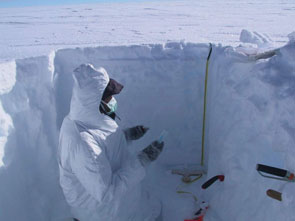|
NEWS NOTES — NEWS
Paleoclimate
Volcanic signatures reveal climate clues
 |
| At Dome C, a research station in Antarctica jointly operated by Italy and France, Joël Savarino samples the ice for telltale signs of sulfur that would indicate that an ancient volcanic eruption had sent sulfur into the stratosphere. Photograph is courtesy of Mélanie Baroni. |
Volcanic eruptions that are strong enough to catapult particles and gases into the stratosphere can profoundly impact global climate. Tens of kilometers above Earth’s surface, volcanic pollutants — most notably sulfurous aerosols — act like tiny mirrors absorbing solar radiation and reflecting part of it back into space, causing temperatures below to drop. Now, scientists have developed a new technique that could help establish firmer connections between ancient eruptions and the climate changes they triggered.
Mélanie Baroni, of the Centre National de la Recherche Scientifique in France, and her colleagues drilled into ice cores in Antarctica to study records of historical eruptions. The team, which reports the findings Jan. 5 in Science, examined the volcanic remnants locked up in the polar ice with a new technique that allowed them to distinguish sulfur compounds that had spent time in the stratosphere — between 16 and 48 kilometers above Earth — from those that had only made it up into the troposphere — up to about 10 kilometers high — before falling back down to the surface. Because only those eruptions that spew material all the way into the stratosphere affect global climate, the team’s new method could allow scientists to determine whether a past eruption might have cooled Earth.
Volcanic sulfur dioxide injected into the stratosphere oxidizes to form sulfuric acid droplets that slowly drift around the globe. These droplets can linger in the stratosphere for several years until they fall back down with snowflakes and deposit as thin layers on the Antarctic snow, says Gregory Zielinski of the University of Maine. Baroni and her team discovered that sulfur compounds that enter the stratosphere undergo a distinctive chemical reaction. “When sulfur dioxide is exposed to light with specific wavelengths that are only present in the stratosphere, it acquires a unique isotopic composition — a fingerprint of a stratospheric process,” Baroni explains.
When the team applied their technique to sulfur compounds of two recent stratospheric eruptions, Mount Pinatubo on the Philippines in 1991 and Mount Agung in Indonesia in 1963, they found that both carried the distinctive stratospheric signature. The team plans to examine ice cores that contain volcanic remnants as old as one thousand years, and hopefully someday as old as one million years. The technique holds promise, Zielinski says, but examining older material could prove more difficult because “as you go back in time, the individual layers get thinner and won’t provide as much sample to analyze.”
Still, Antarctica is a good place to obtain clues to past atmospheric effects from volcanic activity, Zielinski says: Because Antarctica is uninhabited, its ice sheets are unlikely to be contaminated with particles from human-made sulfur emissions, thus likely containing only natural sulfur emissions.
Furthermore, besides providing a new tool to look at the climate impact of past volcanic eruptions, the study also brings atmospheric scientists a step closer to unraveling the chemistry that sulfur aerosols undergo while they are in the stratosphere, which could help improve climate models, Zielinski says. “This study gives us a better idea of how these sulfur compounds behave once they are up there, and that is an important contribution.”

 Subscribe
Subscribe


